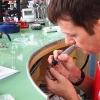Hi Clive,
Great that this fix worked for you..
Generally brute force and watches do not go together.. it usually ends in tears!
With this movement, since it has been extensively reworked with a lot of metal removed from the balance cock (what you refer to as armature), it is possible that a hard knock (drop on the floor) may be sufficient to have bent the balance cock but to to put a significant bend in the cock it needs to have moved beyond its current position. example, if you want to bend a paper clip to a certain angle, you need to push it beyond the desired angle so that it springs back where you want it. Like wise, if you want to straighten it, you need to bent it back beyond straight to get it to spring back correctly. In a watch balance, there is simply not enough space for this without either breaking the balance or displacing the shock-protecting jewels.
A more common problem with old watches is the oiled looses its properties and hardens/gels.. slowing down the watch. This would be a more likely solution. One hint is how the problem ocurred, .. did it happen gradually (pointing to deterioration of the oil) or did it start to misbehave a a knock/drop (bent cock).
Pinion flapping around in the jewel hole is not too good, can you check if the balance has up or down movement? It should have a miniscule amount of up down movement..
Skeletonised automatics are not too common, the automatic weight is too heavy and I would imagine that a drop can cause some distortion of the bridge (part where the rotor is fixed).
Anil




